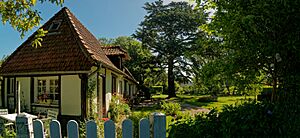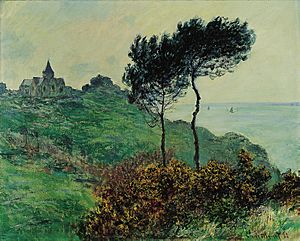Constellations (Miró) facts for kids
Quick facts for kids Constellations (a series of paintings) |
|
|---|---|

L'étoile matinale (Morning Star) 1940, Fundació Joan Miró
|
|
| Artist | Joan Miró |
| Year | 1940 - 1941 |
| Movement | Surrealism |
| Dimensions | 38 cm × 46 cm (15 in × 18 in) |
| Location | Art Institute of Chicago, Cleveland Museum of Art, Fundació Joan Miró, Kimbell Art Museum, Metropolitan Museum of Art, Museum of Modern Art, Philadelphia Museum of Art, Toledo Museum of Art, Wadsworth Atheneum, and various private collections |
The Constellations are a special group of 23 paintings by the Spanish artist Joan Miró. He created them between January 1940 and September 1941. Art experts often call them one of his greatest achievements. They are seen as "miracles that art occasionally bestows."
These paintings celebrate themes like wonder, joy, nature, and love. Miró painted them during a very difficult time in his life. He started them when he was living in France, away from his home in Spain. This was after the Spanish Civil War. He finished them after returning to Spain, while Nazis were invading France.
Because of the war, it was hard to show the paintings in Europe. So, they were secretly sent to the USA in 1944. They were first shown in New York City in 1945. This exhibition was a big deal for artists and thinkers. It showed them that art was still alive in Europe during World War II. These paintings also inspired new artists, especially Jackson Pollock.
Contents
History
How the Constellations Were Created
In the early 1930s, Joan Miró spent time in Paris and his home region of Catalonia, Spain. When the Spanish Civil War started in 1936, he moved to Paris. He stayed there with his wife Pilar and daughter Dolores.
Miró was not very involved in politics. But in 1937, he painted a large mural called The Reaper. It was for the Spanish government's display at an exhibition in Paris. This painting was shown next to Picasso's famous Guernica. This showed Miró's support for the Spanish Republic. Some historians say he painted it to thank the Republic for helping him get to France safely.
As war spread in Europe, many artists left Paris. In August 1939, Miró moved his family to Varengeville-sur-Mer. This was a quiet village on the coast of Normandy, France. He rented a small house there. Other famous artists like Georges Braque lived nearby. This peaceful place helped Miró focus on his art.
Miró often worked on groups of paintings. In Varengeville, he started the Constellations series. The first painting, Sunrise, was finished on January 21, 1940. He wrote to his art dealer, Pierre Matisse, that he was very happy with his work. He felt he was reaching "a high degree of poetry."
Miró completed ten Constellations paintings in France. But the war got worse very quickly. The Nazis were bombing Normandy. On May 14, 1940, Miró and his family had to flee. They left most of their things behind. Miró carried a folder with the ten finished Constellations and blank papers. He hoped to finish the series later.
They traveled south to Perpignan, near the Spanish border. After getting a Spanish visa, they took a boat to Palma, Majorca. This was in the Balearic Islands, where his wife's parents lived. It was safer there. Miró even used his mother's maiden name to avoid being noticed.
After a break, he started painting again. On September 4, 1940, he finished The Nightingale's Song at Midnight and Morning Rain. This was the first Constellation painted in Spain. He painted ten more in Majorca. As things calmed down in Spain, he returned to Mont-roig del Camp. He finished the last three paintings there. The very last one, The Passage of the Divine Bird, was completed on September 12, 1941.
Showing the Paintings
During World War II, it was impossible to show the Constellations in Europe. Miró was becoming a very important artist. His art dealer, Pierre Matisse, often showed his work in New York.
Miró had a contract with Matisse. Matisse would get all of Miró's new art for a monthly payment. But the war made shipping art and sending money very hard. Both Miró and Matisse were frustrated. By the end of 1940, only half of the Constellations were done. Miró felt these paintings were his best work. He didn't want to send them one by one.
By 1944, the contract had ended. Miró wanted to show the Constellations at the Museum of Modern Art (MoMA) in New York. He asked a lawyer named Paulo Duarte for help. Duarte wrote to MoMA, saying Miró wanted to send 22 paintings.
Miró gave very specific instructions for showing his Constellations:
- They must all be shown together.
- They should be in the order they were painted. This would show his journey and feelings.
- They needed special frames so people could see the titles on the back.
- They should be hung simply on a plain white wall, with space between them.
The paintings were shipped to Philadelphia. But MoMA decided not to show or buy the series. It was too expensive to ship and handle. So, everything was given to Pierre Matisse, Miró's dealer.
Matisse paid for the shipping. He then held a show for the Constellations from January 9 to February 3, 1945. However, Matisse did not follow Miró's instructions. He did not show all the paintings together. Only 16 were on display at a time, but they were rotated so everyone could see them.
The Name "Constellations"
When Miró and Matisse talked about the paintings, they didn't use the name Constellations. Miró called them "the series" or "the little paintings." Matisse called them a "wonderful set" or "the twenty-two gouaches."
Even after the 1945 exhibition, people used phrases like "patterns of planets" or "constellations of shining jewels" to describe them. But the official title Constellations wasn't used yet. Miró himself still called them "a group of gouaches" or "this series of paintings."
No one knows exactly when the name Constellations was first used for the series. But by the late 1950s, the name was common. Miró himself approved of it and used it later on.
Who Owns Them?
Miró gave one painting, The Morning Star, to his wife Pilar. It was not sent to New York. Pilar later gave it to the Fundació Joan Miró museum.
Many important art collectors bought the Constellations. These include André Breton and Elisa Breton, Jacques Gelman and Natasha Gelman, and Elizabeth Paepcke. Today, these paintings are in famous museums around the world. These include the Metropolitan Museum of Art and the Museum of Modern Art.
In 1945, the paintings sold for about $400 to $700 each. Today, they are worth much more. For example, Nocturne sold for over $5.6 million in 2001. Woman and Birds sold for over £24 million in 2017.
What They Look Like
Art expert William Rubin described the paintings well. He said Miró used soft, blended colors in the background. On top of this, he created a "labyrinth" of tiny shapes. These shapes were connected by thin lines. The paintings are very detailed and complex.
On the back of each painting, Miró drew a small figure. Inside its head, he wrote information about the artwork. This included his signature, the date it was finished, and where it was painted. He also wrote poetic titles for each piece. Miró said these titles were important. He felt the paintings went beyond just art. They reached into "music and poetry."
Legacy
In 2002, a musician and composer named Bobby Previte created an album. It was called The 23 Constellations of Joan Miró. He was inspired by Miró's paintings. Previte wrote short music pieces, each about 3 minutes long. They matched the small size of Miró's artworks.
Critics said Previte's music was "light, ethereal, and dreamlike." When his music was performed, large images of Miró's paintings were shown. This helped people see how the music and art were connected. Some of Miró's paintings have many dots and dashes. These look a bit like musical notes.
List of Paintings
The titles, locations, and dates were written in French on the backs of the paintings by Miró. All paintings are gouache and oil wash on paper unless noted otherwise. All sheets are about 38 x 46 cm. (15 x 18.1/8 in.). Some sizes vary slightly. Orientation: V = vertical, H = horizontal. All works are in private collections as of 2021 unless noted otherwise.
- Le Lever du soleil (Sunrise) Varengeville: 21 January 1940 (H), Toledo Museum of Art
- L'echelle de l'évasion (The Escape Ladder) Varengeville: 31 January 1940 (gouache, watercolor, and ink, H), Museum of Modern Art
- Personnage dans la nuit guidés par les traces phosphorescentes des escargots (People at Night, Guided by the Phosphorescent Tracks of Snails) Varengeville: 12 February 1940, (gouache, H), Philadelphia Museum of Art
- Femmes sur la plage (Women on the Beach) Varengeville: 15 February 1940 (H), Metropolitan Museum of Art
- Femme à la blonde aisselle coiffant sa chevelure à la lueur des étoiles (Woman with Blond Armpit Combing her Hair by the Light of the Stars) Varengeville: 5 March 1940 (H), Cleveland Museum of Art
- L'étoile matinale (Morning Star) Varengeville: 16 March 1940 (tempera, gouache, egg, oil, and pastel, H), Fundació Joan Miró
- Personnage blessé (Wounded Personage) Varengeville: 27 March 1940 (H)
- Femme et oiseaux (Woman and Birds) Varengeville: 13 April 1940 (H)
- Femme dans la nuit (Woman in the Night) Varengeville: 27 April 1940 (V)
- Danseuses acrobates (Acrobatic Dancers) Varengeville: 14 May 1940 (watercolor, V), Wadsworth Atheneum
- Le Chant du rossignol à minuit et la pluie matinale (The Nightingale's Song at Midnight and Morning Rain) Palma de Majorca: 4 September 1940 (H)
- Le 13 l’échelle a frôlé le firmament (On the 13th, the Ladder Brushed the Firmament) Palma de Majorca: 14 October 1940 (V)
- Nocturne (Nocturne) Palma de Majorca: 2 November 1940 (H)
- La Poétesse (The Poetess) Palma de Majorca: 31 December 1940 (H)
- Le réveil au petit jour (Awakening in the Early Morning) Palma de Majorca: 27 January 1941 (V), Kimbell Art Museum
- Vers l'arc-en-ciel (Toward the Rainbow) Palma de Majorca: March 11, 1941 (V) Metropolitan Museum of Art
- Femmes encerclées par le vol d'un oiseau (Women Encircled by the Flight of a Bird) Palma de Majorca: 26 April 1941 (V)
- Femmes au bord du lac à la surface irisée par le passage d’un cygnet (Women at the Border of a Lake Made Iridescent by the Passage of a Swan) Palma de Majorca: 14 May 1941 (V)
- L’Oiseau-migrateur (The Migratory Bird) Palma de Majorca: 26 May 1941 (V)
- Chiffres et constellations amoureux d’une femme (Ciphers and Constellations in Love with a Woman) Palma de Majorca: 12 June 1941 (V), Art Institute of Chicago
- Le Bel oiseau déchiffrant l'inconnu au couple d'amoureux (The Beautiful Bird Revealing the Unknown to a Pair of Lover) Mont-roig del Camp: 23 July 1941 (V), Museum of Modern Art
- Le Crépuscule rose caresse le sexe des femmes et des oiseaux (The Rose Dusk Caresses the Sex of Women and of Birds) Mont-roig del Camp: 14 August 1941 (V)
- Le Passage de l’oiseau divin (The Passage of the Divine Bird) Mont-roig del Camp: 12 September1941 (V), Toledo Museum of Art
See also
 In Spanish: Constelaciones (Miró) para niños
In Spanish: Constelaciones (Miró) para niños



